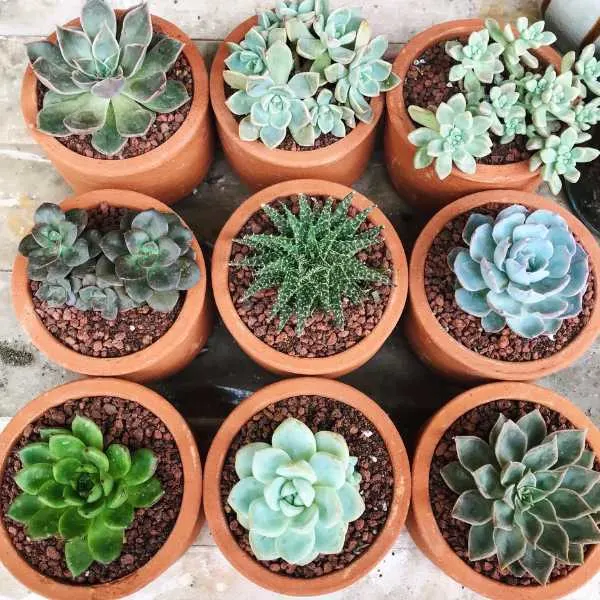How to Save an Overwatered Succulent – 6 Easy Tips
Have you seen a succulent that developed dark, mushy leaves at the base? There is a chance that this was an overwatered succulent. Luckily, you can save an overwatered succulent plant by following simple steps.
This article explores how to identify that your succulent plant is overwatered. We shall also show you how to fix overwatered succulent plants.
Succulents brighten up any space (indoors and outdoors) and having them die on your watch is not something you would want because they are easy to maintain.

Related Article:
Signs of an Overwatered Succulent Plant
When your plant starts showing early signs of overwatering, you need to get rid of this excess water to begin the process of saving the plant. An overwatered plant is drowning and unless something is done, you will certainly lose the whole plant. The earlier you intervene to save the plant, the greater the chance of success.
Here are some signs that you may have an overwatered succulent;
Waterlogged Soil
When you check the soil where your succulents are growing, you should expect to find separate grains of earth, not clumps. Clumped soil is an overwatered sign.
Color of the Leaves
Healthy succulents have plump fresh leaves. The leaves close to the bottom are brown (or dark) if your succulent is overwatered. The leaves at the bottom will look bloated and feel squishy (mushy) when you touch them.
At the base where the leaves connect to the stem of the plant, the color turns translucent. The leaves will also feel lighter, fragile, and easy to pluck from the stem. This fragility results from the build-up of excess water that breaks down the cell walls.
6 Simple Tips on How to Fix Overwatered Succulent Plants

#1. Early Intervention
Do not wait until the leaves begin to fall off from the plant before you start working on saving it. Once the plant shows the first signs of overwatering, that is the time to intervene.
#2. Keep the Plant Away from the Sun
This may sound like contradicting advice. After all, isn’t the goal to get rid of excess water from the soil? And what better way to do so than by letting excess moisture evaporate?
However, there is a good reason for this. The succulents are already under a lot of stress from too much water. Exposing the plants to direct sunlight will compound the problem.
Place the succulents in a place where there is indirect light without subjecting them to the effects of direct sunlight. This means that the plants will still benefit from the exposure to the light without risking being burnt.
#3. Air-Dry the Roots
Remove the succulent from the container and get rid of the excess soil stuck onto the roots. Check if there are any rotten roots and remove them as well. Leave the plant on a flat surface to let the succulent roots dry for about 2-3 days.
Once the roots are dry, replant the succulent in a container with a new potting mix. Do not water immediately after replanting. Take about an extra week or so before re-watering the plant and ensure the soil is not waterlogged.
#4. Change the Soil
The goal of changing the soil is to improve the drainage and rescue the overwatered succulent. You may not have to change all the soil if the succulent is planted in succulent soil/potting mix.
You can add more perlite to the soil to make it more porous and improve its drainage. If you decide to add perlite, first get rid of the topsoil in your container. This is where algae and other fungi reside.
#5. Propagate Your Succulent
Sometimes you may find it impossible to recover your overwatered succulent plant. In this case, you can try leaf propagation. It is a difficult and tricky process.
You will be replacing the dead leaves with other fresh leaves and hope that they thrive. To do so, carefully remove all the dead leaves from the plant by holding the stem in place.
Pull healthy leaves from the plant carefully by performing a twisting motion that will pull off the leaf from the plant without damaging the plant. If you cut the leaves poorly, the chances of them sprouting roots diminish.
Place the leaves on a paper towel (in a dry place and away from direct sunlight) for about a week to let the cut ends dry.
After this, place them in the potting mix and spray them with water every couple of days or when you feel the soil is too dry. Once the leaves develop roots, you will have new succulents and you can transplant them into other containers as you wish.
#6. Create a Watering Routine
Figuring out a watering routine for your succulents can be tricky. Once you have saved your overwatered succulents from dying, I’m sure you would not want to repeat the mistake.
Check your soil carefully each time you want to water your succulents. Press your finger into the soil before watering. If the soil feels dry, water the plant but avoid waterlogging. Do not under-water as well.
Take into consideration the climate of where you reside. If you live in a dry area, you may need to water your succulents more often than people living in humid areas.
The season also matters. Succulents will demand more water during the summer season when the weather is hot than during the cooler Winter months.
The type of succulent you have in your home also determines your watering routine. Some demand more water than others. For instance, you will need to water Aeoniums more frequently than cacti.
Final Thoughts on How to Revive Overwatered Succulent Plants
Brownish, dark, or yellowish leaves at the base of your succulent indicate that your plant is overwatered. The leaves get weak, squishy, and easily fall off the stem. If this problem is not checked, it spreads to the other leaves up the stem until the whole plant is infected. It dies soon after.
To have a better chance of saving an overwatered succulent start before the whole plant is infected. Control the way you water the soil. Succulents thrive in well-drained soils. Replace the potting soil if need be and ensure you have a good watering routine once you replant the succulent so that it can grow healthy.

